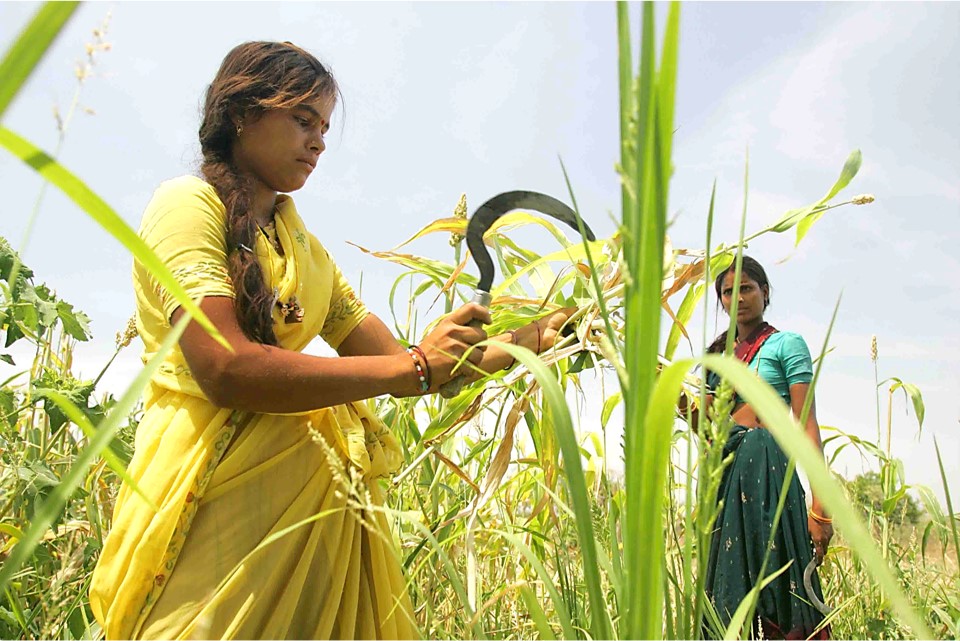

In this chapter we will combine what we have learned about calculating the number of missing females, about fertility, family structure, and even human trafficking. We will focus on son preference and marriage payments. Both of these are heavily influenced by culture and tradition, but economic pressures help explain the origin and continuation of these practices. Both of these practices can result in hardship, even mortality for people identified as girls and women. People identified as boys and men may also be adversely affected.

In earlier chapters we mentioned that girl infants and children may experience unnaturally high mortality rates due to preference for boy children. Figure 24-1 below shows some unusually low and some unusually high sex ratios at birth. If the data can be believed, in 2019 Sichuan province in China had a sex ratio of 97 boys per 100 girls, in contrast to the biological sex ratio of 105-6, while Tianjin had a sex ratio of 123. In 2018, one Indian province had a sex ratio of 92 while another had a sex ratio of 132.


Whatever these data say, it is common knowledge that sex ratios at birth, especially for “higher order” children (the 2nd, 3rd, 4th child) tend to be higher in South Asia and East Asia. In contrast to the datum in the Table above, the CIA World Factbook reported the sex ratio at birth for China to have been 111 in 2020, not 105.1.
A 2016 study in the Canadian Medical Association Journal [1] discovered that the sex ratio at birth did not vary much among ethnic groups in Canada, except in the case of Canadian women born in India whose first and second children were female. For that group of women, the sex ratio at birth for the third child was 196:100, more than 80% higher than normal. The greater the number of induced abortions between the second birth (female) and the third birth, the more likely the third child was to be male, indicating that female fetuses were being aborted. An abortion at 15 weeks of pregnancy or later was associated with an almost four times greater ratio of baby boys to baby girls than normal.
M. Das Gupta (2009) explains that Korea, China, and northwestern India, places where son preference has manifested itself especially strongly, have traditional political systems which are very much organized around male ancestry. In East Asia, ancestor worship helps reinforce notions of loyalty, order, and political hierarchy, and requires ceremonies carried out by men. Property is typically inherited by men only.
In rural areas of East and Southeast Asia, a rural man’s identity, social status, and access to resources may be determined by his position in a clan, with the oldest son of an oldest son at the top. A woman’s identity is determined by her husband. Women born into the clan are required to leave and marry men of other clans. They leave their land and forego any inheritance other than what is given to them as part of the marriage settlement.
Since women live with their in-laws once married, it is their brothers who look after their aging parents.
Ding and Zhang (2014) find evidence that, in rural China, having a son has been perceived as a good investment. Using 2003 data on three thousand rural Chinese households, Ding and Zhang found that households having at least one son received more gifts and cash transfers from family and friends, gave and lent more to family and friends, and invested more in their agricultural enterprises and family businesses.
Rural Asian parents have looked mostly to their sons for labour, old age support, continuation of family influence, and ceremonial obligations. This has been true in most societies through human history. Most societies have been patrilineal, with surnames, titles, privileges and property passing from father to son.

The importance of sons financially and culturally has led, in various times and places, to a sex ratio at birth that is higher than normal, and to higher-than-normal mortality for girls and women. We saw that when we observed the high number of girls and women calculated to be missing from China during the twentieth century, back in Chapter 7.
Son preference leads to higher-than-normal sex ratios at all ages. According to the CIA World Factbook, in 2020 the sex ratio of the Canadian population was 0.98, but it was 1.06 in China. The sex ratio for 15-24 year-olds was 1.17 in China compared to 1.07 in Canada, meaning ten extra males 15-24 for every 100 girls compared to the situation in Canada.
What are the consequences of a shortage of females? We might think that there would be a lower rate of family formation, ceteris paribus, with consequences for fertility. Men would have to look abroad to find wives, with consequences for immigration and human trafficking. We might expense violence against women to rise. Research indicates that the story is not so simple.
Trent et al. (2013) found that, in India during 2005-6, a shortage of females was associated with a small increase in the likelihood that women would marry before age 16 and/or be coerced into having sex. Yet overall, the shortage of women seemed to result in women being treated better, not worse. A 2014 review of twenty studies on the subject by Schacht, Rauch and Mulder found no clear correlation between a shortage of women and violence. In a 2016 article, Schacht, Tharp and Smith, having studied over three thousand American counties in 2010, found that a shortage of women was correlated with lower rates of murders and sexual assaults.
Schacht et al. found evidence that a shortage of females leads more domestic violence but also to higher rates of marriage, increased practice of monogamy, less inter-male conflict over women, and less rape.
In a more recent article, Pabst, Walfield, and Schacht (2022) correlate violence against women in the United States with a skewed sex ratio, but not necessarily one skewed in favour of men. In fact, a shortage of men seems to be a higher risk situation for American women than a surplus of men.
A surplus of men may ease pressures on brides’ families to pay high dowries to grooms’ families.
 There has been in many societies – including those of Europe – a tradition of groom price. It is based in patriarchy and income inequality, resulting in the situation where social status and income depend mostly on the husband’s social connections and wealth. To secure the best match for one’s daughter in terms of privilege and wealth, a dowry must be offered. Dowry and groom price are synonymous.
There has been in many societies – including those of Europe – a tradition of groom price. It is based in patriarchy and income inequality, resulting in the situation where social status and income depend mostly on the husband’s social connections and wealth. To secure the best match for one’s daughter in terms of privilege and wealth, a dowry must be offered. Dowry and groom price are synonymous.

Without the backdrop of social safety nets and institutions to protect human rights, marrying into financial and social security is even more attractive. Parents may greatly influence or completely control who marries whom.
In countries where groom price is paid, groom price provides a disincentive to raise girl children, because girls will eventually require a dowry and an expensive wedding. As one advertisement for a fetal-gender test kit put it, “Spend 500 rupees now to save 500,000 rupees later.”[2]

Instead of groom price, in some countries there is a tradition of “bride price.” Bride price is the norm in most of China, and used to be the norm in southern India. Where land is plentiful and low-cost, and women are expected to do manual work, bride price is often found. It can reflect compensation to the bride’s family for the expenses of raising her and for the emotional cost of letting her go live with another family. It can reflect her future value as a worker. Bride price can be considered a form of inheritance, some of which the bride herself may be able to keep or control.
Both groom price and bride price involve gifts of jewelry, cash, land, or an annuity, some of which may remain in the possession of the woman. This can serve as a safety net for the woman. For example, in Iran a bride traditionally receives a gift from the groom called “mahr”. Should divorce occur, she can take the mahr with her.
Both groom price and bride price help a couple build their new home and life together.
Bride price helps counter son-preference, giving families an incentive to care for girl children who will eventually leave the family home and work for another family. The bride price received for a daughter can be used to pay the bride price needed when finding one’s son a wife[3].
When a woman lives with her in-laws, she may be dependent on them for protection, sustenance, and approval, but may have the lowest status in the family. The husband’s parents are likely to influence her and her husband’s fertility decisions. Entering into the husband’s family often affects women’s development, education and employment. Commonly, daughters-in-law work for the family business and/or take care of the household while the men are employed elsewhere.


Baht and Halli (1999) studied groom price in India, which rose faster than the rate of inflation during the twentieth century. As a cultural practice it spread from northern India and upper-caste families to eventually include most of the population. Baht and Halli correlate groom price in Indian between 1911 and 1971 with the sex ratio among people of marriageable age.
As the population of India began to grow rapidly, younger cohorts became larger in size than older cohorts, and the availability of marriageable men, who are typically older than the women they marry, declined. Because of that declining availability, the age gap between marriage partners narrowed.
As India experienced mortality transition, fewer women died in childbirth. That meant fewer widowers (men who have lost their wives) available for re-marriage, another reason for the declining availability of men. The overall declining availability of men helps explain the increase in groom price during that period.

Siwan Anderson (2003) used a Gale-Shapley matching model to pair off hypothetical men and women of different social classes and different incomes and study the implications for groom price.
The Gale-Shapley matching model is an incredible tool used to match students and universities, doctors and hospitals, and transplant donors and recipients. Just like Gale’s proof that the average number of sexual partners of men and women must be the same if the numbers of men and women are the same (see Chapter 11), his matching model is elegant and simple.
The matching model requires members of one of the parties, say the women, to line up. The members of the other party, which in the case of heterosexual marriage would be the men, then take action. Each man lines up in front of the woman he is most interested in. At that point, each woman chooses the man she is most interested in, out of the men who have lined up in front of her. She cannot choose a man who has lined up in front of someone else. The first iteration is now complete. In the second iteration, the men who have been rejected now line up in front of their second-favourite woman. After they have done so, each woman either retains her previously-chosen man or chooses one of the new men lined up in front of her. The second iteration is now complete, and the rejected men try again.
This algorithm continues until each man, starting with his top choice but working down his list as necessary, has found a woman for whom he is her top choice. It can be shown that this outcome is an equilibrium – no man can do better, since the women he prefers rejected him, and no woman can do any better, since if there is a man she prefers to the one she has, it is a man who doesn’t want to be with her since he never lined up in front of her. Thus each person can do no better than what they have done. The matches are stable.

Anderson assumed that brides’ families offer dowry to grooms for two reasons: income and class. Lower class families want their daughters to marry into the upper classes. Anderson used the Gale-Shapley algorithm to show that, when income becomes more variable within each social class, the richer lower-class families begin to compete with the poorer upper-class families for grooms. The upper-class families have to raise their bids on the poorest upper-class grooms, and of course the richer upper-class grooms “cost” even more. In this way, groom prices inflate as income becomes more variable. Groom prices have to inflate if people are to continue marrying within their class.
Reena Kukreja, in her 2020 book “Why Would I be Married Here?”, describes the migration of poor, darker-skinned Dalit and Muslim girls to rural northern India. They are going there to meet and live with the husbands selected for them, poor men of their own social background. The parents of these girls do not have the money to secure local Dalit and Muslim husbands for them. The local men are upwardly mobile and are demanding high dowries to help them get ahead. For whatever reason or insanity, they are willing to accept a lower dowry for a lighter-skinned wife.
If incomes become equalized between upper and lower classes, the poorer upper class families can no longer outbid the richer lower class families, and lower and upper classes will intermarry. Because class is less significant, there is less reason to offer groom price.
In Europe, groom price disappeared as the economy modernized and income inequality lessened. Sons were becoming less likely to work in a family business, or use their family’s land. Women were eventually allowed to inherit property. Their prospects depended less on their family background than previously. Educating children became an important way to transfer privilege to sons and to daughters.
We’ve come a long way in analyzing demographic phenomena with economics, and explaining the impact on the economy of demographic phenomena. Let’s sum up in the next chapter.

1. Explain how the following might affect son preference and groom price or bride price.
a) mechanization of agriculture
b) reductions in infant mortality
c) mandatory schooling for all children ages 5-14
Groom price is a payment from a woman's family to a man's family on the occasion of their marriage.
See groom price.

